The best lenses for Nikon D750 from wide angle to telephoto ones.
The Nikon D750 is considered to be one of the most affordable, but yet highly functional full-frame DSLRs. This camera delivers images of professional quality, and it will not cost you more than $2,000!
The Nikon D750 is equipped with many versatile features that make this model perfect for professional use, for example, for real estate photography. If you are going to purchase this camera, it is time to think of the premium accessory to complement it, like high-quality lenses for Nikon D750.
This review will help you choose the best lens for Nikon D750. The accessories described here include prime and zoom lenses, those that provide a wider perspective or telephotos with higher magnifications.
No matter what kind of photography you do, make sure to decide on the lens that would be appropriate for your shooting needs.
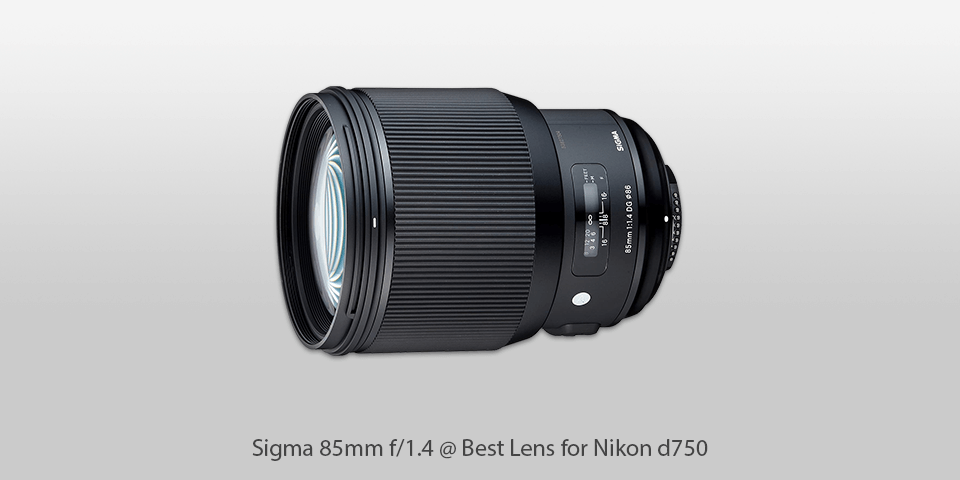
Mount: AF| Diaphragm blades: 9 | Autofocus: good | Min focus distance: 850mm | Max magnification: 0.12×| Filter thread: 86 mm | Dimensions (WxL): 85 mm | Weight: 1.70 lbs
⊕ High quality of images
⊕ Sharp photos
⊖ Bulky and weighty
The Sigma 85mm f/1.4 is a great optical accessory with a variety of features great for taking portrait photos. With its ultra-fast f/1.4 aperture, this lens can create a smooth bokeh effect that will make your images more captivating.
The lens incorporates two SLD elements that reduce undesirable aberrations delivering clear and sharp pictures. Many photographers consider this model as the best lens for Nikon D750, as it comes with a super multi-level coating that prevents unwanted ghosting and flare.
The lens is equipped with a Hyper Sonic AF motor that ensures quick and precise focusing. Moreover, you can adjust the focus manually by turning the control wheel. The lens is manufactured from heat-resistant composite material that is quite strong. It also features a brass bayonet mount.
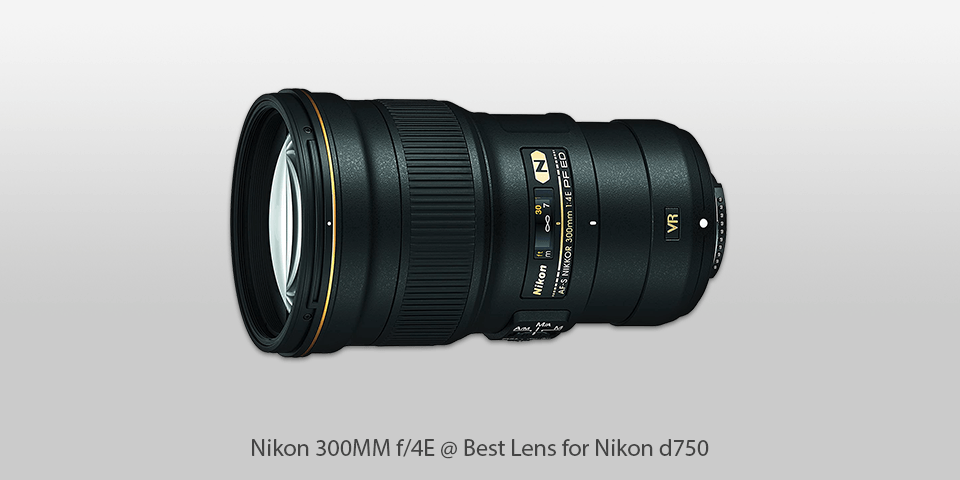
Mount: E | Diaphragm blades: 9 | Autofocus: good | Min focus distance: 1.4 m | Max magnification: 0.24x| Filter thread: 82 mm | Dimensions (WxL): 300 mm | Weight: 1.66 pounds
⊕ Doesn’t weigh much
⊕ Great edge-to-edge sharpness
⊕ Image stabilization
⊖ Cannot be used on some older cameras
Featuring a compact and lightweight design, it is one of the most popular prime lenses for Nikon D750. Its powerful Phase Fresnel element allowed engineers to reduce the size of the lens that resulted in a lighter and more ergonomic construction in comparison to other 300mm lenses.
In combination with one ED glass element, it successfully prevents unwanted chromatic aberrations and color fringing. The lens is fitted with a Silent Wave Motor AF system, the main function of which is to ensure fast and noiseless autofocusing.
VR image stabilization serves for neutralizing camera shake and delivers sharp and accurate shots.
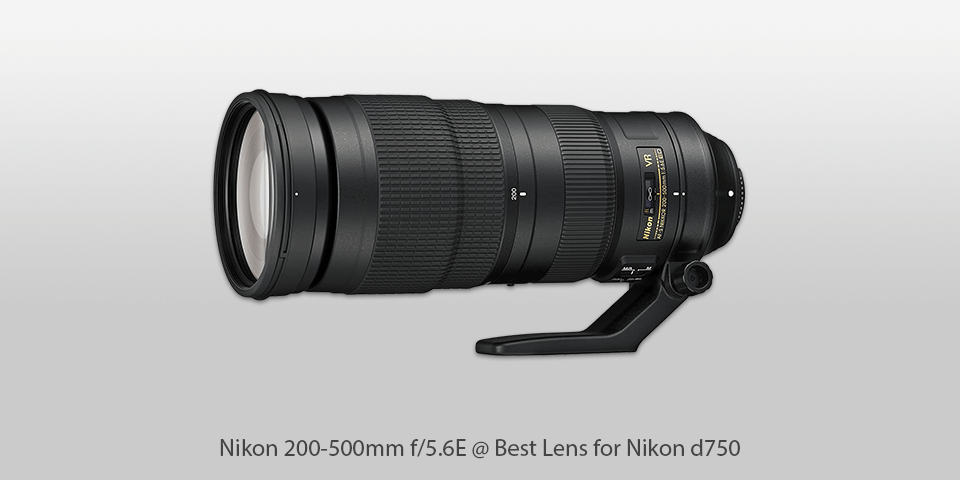
Mount: AF | Diaphragm blades: 9 | Autofocus: good | Min focus distance: 2.2 m| Max magnification: 0.22x | Filter thread: 95 mm | Dimensions (WxL): 95 mm | Weight: 5.07 pounds
⊕ Accurate optics
⊕ Powerful telephoto reach
⊕ Image stabilization
⊖ Zoom is not powerful
It is a wide angle lens for Nikon D750 for shooting nature, sporting events, landmarks or other distant objects. The lens has a super-fast f/5.6 constant aperture that allows you to create a blurry background effect across the whole zoom range.
All the elements of a lens are covered with a super integrated coating that reduces flare and ghosting and ensures highly contrasted, clear images. The Wave Motor AF system enables the lens to focus smoothly and silently when capturing images or recording videos.
The electromagnetic diaphragm functions in synchronization for faster shutter speed. Fitted with the image stabilization feature, the Nikon 200-500mm f/5.6E delivers steady and clear shots.
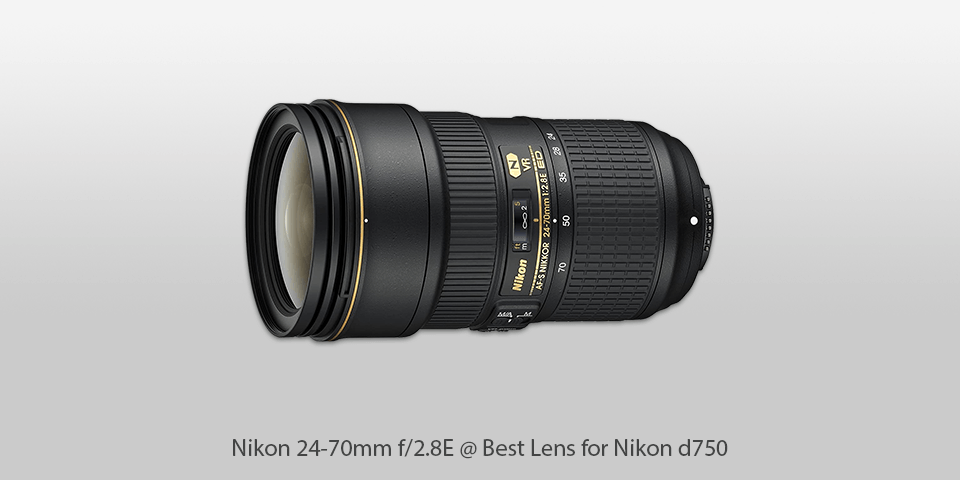
Mount: AF| Diaphragm blades: 9 | Autofocus: good | Min focus distance: 0.38m | Max magnification: 0.28x | Filter thread: 82 mm | Dimensions (WxL): 72 mm | Weight: 2.36 lbs
⊕ Optical stabilization
⊕ Clear picture
⊕ Solid construction
⊖ Sometimes produces distorted images
The AF-S NIKKOR 24-70mm f/2.8E ED VR has features that are superior to the characteristics that its famous predecessor possesses. Improvements have affected almost every aspect of this lens: speed, quality of image, control, consistency, durability, and optical stabilization.
As a result, the photographers got one of the most versatile and powerful lenses for Nikon D750. This model features a permanent f/2.8 maximum aperture, as well as the electromagnetic aperture mechanism.
Its optical design integrates ED glass that prevents chromatic distortion throughout the entire zoom range. Use this powerful lens with Nikon full-frame DSLR and you will get spectacular photos of the premium quality. This wide angle lens for Nikon D750 will bring your shooting experience to a new level.
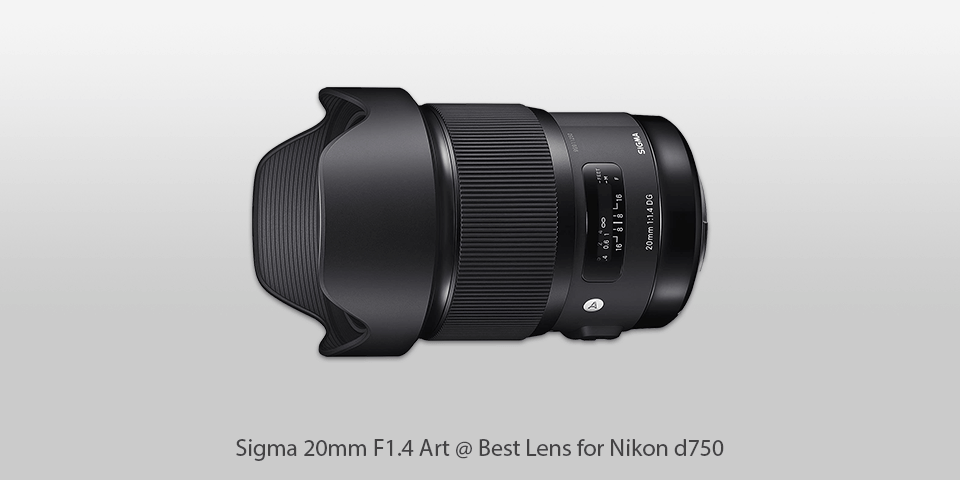
Mount: F | Diaphragm blades: 9 | Autofocus: good | Min focus distance: 27.6 cm | Max magnification: 0.14×| Filter thread: 20 mm | Dimensions (WxL): 20 mm | Weight: 2.10 lbs
⊕ Edge-to-edge sharpness
⊕ Almost no distortion
⊕ Closest focusing distance is short
⊖ Corners and edges are dark
The Sigma 20mm F1.4 Art is a great travel lens for D750 that delivers a wide-angle view. It is meant for full-frame DSLR but will be also a great accessory for APS-C cameras. The lens features the widest possible f/1.4 aperture that ensures extra-bright images and makes this model the best lens for Nikon D750 from the start.
The lens was developed with special attention to its edge-to-edge optical performance that enhances the sharpness and overall quality of the image. It features FLD and SLD glass elements, which in combination with an optimized lens capacity reduces typically occurring aberrations improving the quality of photos greatly.

Mount: F| Diaphragm blades: 9 | Autofocus: good | Min focus distance: 0.8m | Max magnification: 0.14x | Filter thread: 67 mm | Dimensions (WxL): 85 mm | Weight: 1.50 lbs
⊕ Ultra-sharp photos
⊕ Quick focusing
⊖ Requires calibration
The Tamron SP 85mm F/1.8 is the world’s first 85mm lens with a fast aperture and optical stabilization feature. Its bright optical viewfinder ensures great performance in poorly lit places.
Being considered as one of the best lenses for Nikon D750, this model is popular because of its fast F/1.8 aperture that creates a perfectly balanced picture with a focus on a subject against a blurring background.
Its focal length of 85mm allows a photographer to take stunning portrait photos with perfect proportions. The SP 85mm F/1.8 features low-dispersion glass and extra-low dispersion glass elements that neutralize color fringing and deliver colorful images of high quality.
| Image | Name | Features | |
|---|---|---|---|
 |
Sigma 85mm f/1.4
Our choice |
CHECK PRICE→ | |
 |
Nikon 300MM f/4E
Compact |
CHECK PRICE → | |
 |
Nikon 200-500mm f/5.6E
High Quality |
CHECK PRICE → |
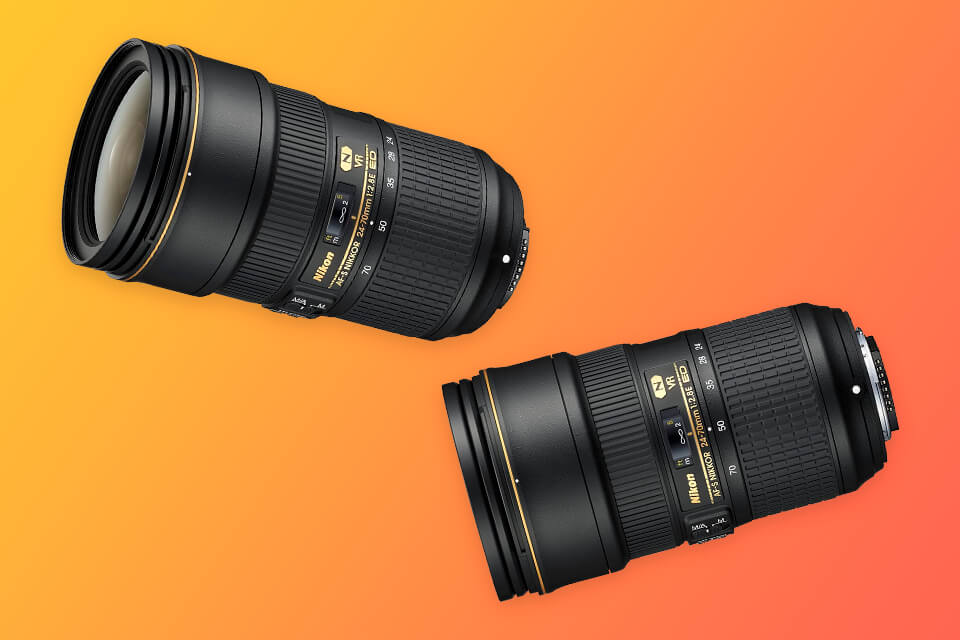
Aperture is calibrated in f/stops and indicated in numbers like 2.8, or sometimes 1:2.8. The lower this number is, the more light is transmitted through it. In theory, the greatest aperture you can achieve is f/1, but in practice, the maximum aperture even of the brightest lenses equals to f/1.2. Most photographers buy the lenses with the average aperture range from f/2.4 to f/3.2. All in all, the higher the f-number is, the more affordable the lens is.
DX and FX indicate the size of your camera sensor. The image sensor of the FX camera, which is also known as full-frame, measures approximately 36mm x 24mm, and the size of the image sensor of the DX camera is 24mm x 16mm.
You can use various lenses for these devices, but it is better to use the accessory suitable for their formats. DX camera equipped with a full-frame lens will produce the magnification of 1.5X. A full-frame camera with a DX lens will trim the picture to adjust it to the size of the sensor.
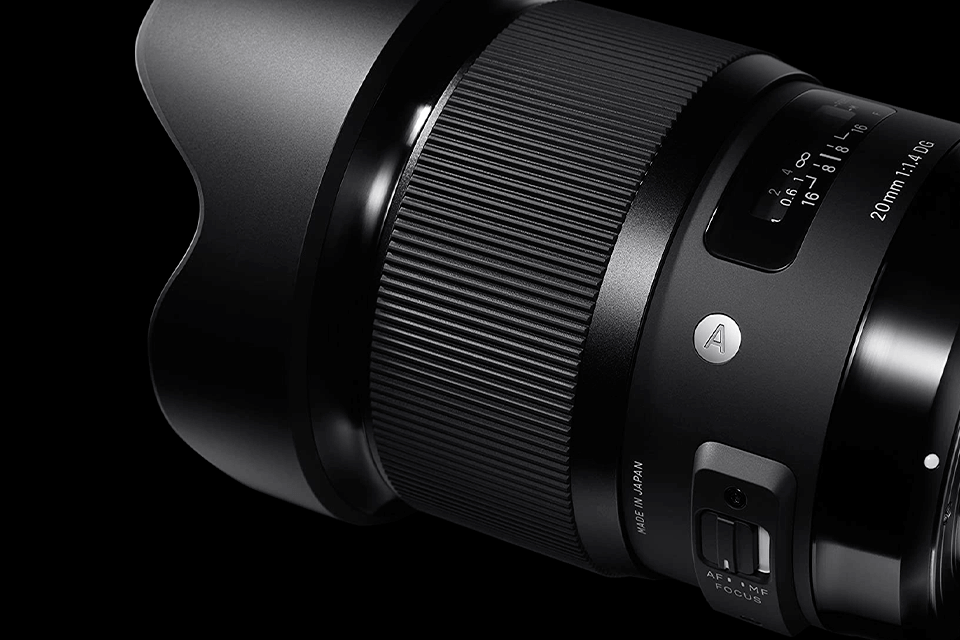
The main difference between zoom and prime lenses is that the later has a fixed focal length, which is also a perspective. By moving in or out, you can reduce or enlarge the perspective. Zoom lenses will enable you to modify the perspective according to the zoom range.
The design of D740 is constructed in such a way so that water cannot penetrate it. But the construction is not fully waterproof.
The D750 is a full-frame camera, but it is also compatible with DX lenses. To ensure a trouble-free functioning of DX lenses when using them with the D750, enter the Image Area menu of your DSLR and configure the camera for the “Auto DX Crop” mode. By doing so, you can avoid unwanted vignetting. But you can also find many Nikon FX lenses for D750 on the market.
Yes, the D750 is fitted with Nikon’s Vibration Reduction feature that will reduce shake, ensuring steady and clear images.
Although Nikon released the D750 in 2014, it is still one of the most popular models of the DSLRs. It is equipped with a great range of features for shooting impressive pictures. The D750 is a perfect model for both professional and beginning photographers.

 Rating
Rating